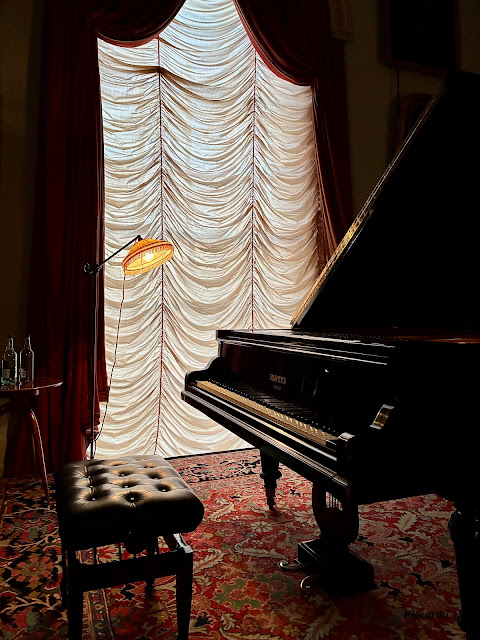
I am in All Saints, Burnham Thorpe, the church where Admiral Lord Nelson’s father, Edmund, was rector from 1755 to 1803. Joseph Haydn’s
Mass in D Minor, originally entitled Missa in Angustiis (Mass for Troubled Times) but better known as the Nelson Mass, is raising the rafters.
First performed in Eisenstadt, where Haydn was under the patronage of the Esterházy family, in September 1798; Austria was under threat from the French and had lost four major battles against Napoleon in a year. What Haydn did not know, however, when completing the mass, was that on August 1st of that year the French Navy had been thrashed by Rear-Admiral Horatio Nelson and his jolly tars in Aboukir Bay, at the mouth of the Nile. Then, when in 1800 Nelson and Lady Hamilton visited the Esterházy Palace, they probably heard this mass, and certainly met Haydn, and the appellation Nelson Mass was adopted.
Kyrie, eleison - Lord, have mercy
Earlier that week we were 288 steps, 66 metres (217 feet), above ground level atop the West Tower of Ely Cathedral. Completed in 1322 the tower has magnificent views over the city and across the watery fenland that surrounds us.
Within the glorious nave below, for some reason, perhaps a ghostly premonition of his imminent death, Tom Lehrer’s Vatican Rag comes to mind as I
get down on [my] knees,
Fiddle with [my] rosaries,
Bow [my] head with great respect,
And genuflect, genuflect, genuflect!
Is that sacrilegious? I know not.... Just thinking of those 288 steps – and Lehrer:
Do whatever steps you want if
You have cleared them with the Pontiff.
Everybody say his own
Kyrie eleison,
Doin' the Vatican Rag.
Gloria in excelsis Deo – Glory to God in the Highest
I move from minor to major, from allegro moderato to allegro. Oh lord, I beseech thee to take away my guilt. And back home in Snettisham I rise with the sun and celebrate the glory of the world, rejoicing in the beauty of the morning. Although I have no faith (mea culpa, mea culpa), I celebrate the light of the world, and am increasingly moved by and fond of our country churches, St Mary’s Snettisham being a prime example. It was here, two years ago, that I was privileged to be asked to be official photographer for two concerts arranged by Music in Country Churches, one of which was visited by its Patron, King Charles.
Since 1989, Music in Country Churches has arranged concerts in over 60 country churches and made donations of more than £600,000 to the churches that have hosted its concerts. It now regularly holds concerts in 14 counties. The King has taken a keen interest in the Charity and the causes it supports, and often attends concerts, such as that held in Snettisham in 2023 and at St Mary the Virgin, Wiveton on Tuesday, July 22nd this year.
Which brings to mind Van Morrison, of course.....
G.L.O.R.I.A. (Gloria)
G.L.O.R.I.A. (Gloria)
I'm wanna shout it ev'ry night (Gloria)
I'm wanna shout it ev'ry day (Gloria)
Yeah, yeah, yeah, yeah, all right
Credo – I believe
But, sadly, I don’t.... believe that is, but I am happy that others do, and so, in D major and with allegro spirits I make my way, again kindly invited to be the official photographer, to another evening of fine music organised by Music in Country Churches. This is at the early fourteenth century Church of St Mary the Virgin overlooking the Glaven valley, towards Cley, at Wiveton.
A summer’s evening in rural Norfolk. Possible showers. Floral frocks and lightweight suits.
Pol Roger and quails’ eggs at the reception. Security in force. The people line towards the country church. A big, black, German car arrives.
A man, carrying his allotted years with confidence in a sharp blue suit, alights. He shakes various hands, and speaks, smiling.
He approaches a group of local onlookers. He pats a dog, then returns to the planned itinerary, escorted, via handshakes and pleasantries. A baby extends to him her pink blanket. He generously declines the offertory, and enters the church, the packed pews attendant in their standing. Musicians at the ready. Blue and yellow light falling from the high windows.
Sanctus – Holy or Sacred
An introduction to the purpose of this concert from chairman Matthew Rice. The initial success of MICC was due to the friendship between its founder, Ruth, Lady Fermoy, then 80 years young, and its main sponsor Sebastian Walker. After her brother Sebastian’s untimely death in 1991, Mirabel Cecil became a Trustee of Music in Country Churches. When the much-loved Lady Fermoy died in 1993, her grand-daughter, Lady Jane Fellowes, became Chairman until 2000. Now the Charity is fortunate to have the artist and author Matthew Rice, himself a pianist, as Chairman. Mirabel Cecil died in 2024, and this concert is in part a celebration of her life.
An introduction to the music from the conductor, internationally recognised as a leading interpreter of Italian baroque music, Adrian Chandler,
unable to play his violin having recently suffered a fall in the Brecon Beacons. Crossing Borders – eighteenth century travels across the Italian border. The music strikes up.
Benedictus - Blessed
And so, in D minor, and allegretto, to blessed Burnham Thorpe, the next day, where Nigel Short
conducts his virtuosic award-winning choir Tenebrae, and the Music in Country Churches Chorus, accompanied by acclaimed violinist and conductor Steve Bingham’s Ad Hoc Sinfonia Strings in a spirited rendering of the Nelson Mass, or Mass for Troubled Times.
And, though a tranquil evening in rural Norfolk is far removed from the turbulence of the troubled world, there are pertinent reminders of difficult times in the church which dates from the 13th century and which has the unique right to fly the white ensign, the official flag of the Royal Navy, from its tower. Timbers from Nelson's flagship, the HMS Victory, were donated by The Admiralty and were used to build the altar, lectern, and rood screen.
And filling the heavens, hanging at the west end of the nave are flags flown by HMS Nelson, and one used by HMS Indomitable at the Battle of Jutland.
Agnus Dei – the Lamb of God
So, from D major to G major, initially adagio, then back to D major and vivace, the mass ends with Dona nobis pacem – grant us peace – splendidly filling the luminous interior of the church, the trumpets rising above the thunderous timpani as the combined choirs fill the air with a plea for peace.
It is triumphant, and, despite the title, it is optimistic. There is something joyous about the sound as it rolls around the church walls and out into the evening sunshine, as the performers and congregation stroll down the lane to the Church Hall for refreshment en plein air,
smiles catching the sun as it begins to cast long shadows.
As we leave the village, my hero, Horatio Nelson, waves his arm and winks his eye in my mind, living beyond his days. It has been glorious; victorious.... And we pray for peace, the image of a lamb so innocent and vulnerable and right. And the opening line of Twelfth Night comes to mind....
Enter Orsino, Duke of Illyria, Curio, and other Lords,
[with Musicians playing.]
ORSINO
If music be the food of love, play on.
If only.....
May the Great God whom I worship Grant to my Country and for the benefit of Europe in General a great and Glorious Victory..... For myself individually I commit my Life to Him Who made me.....
Amen. Amen. Amen.
Horatio Nelson






























































